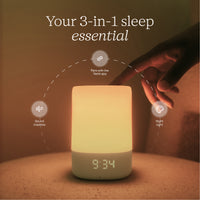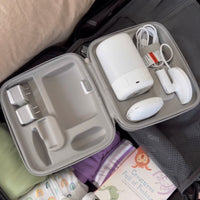Going back to work—whether it’s after family leave, a long vacation, or during some new “return to office” rules—can feel like starting a new school. You may feel a bit different, the other people may act unfamiliar, and the demands on you can seem like a swirl and even downright impossible at times. Even recent research found that for fathers, stress around baby’s sleep is associated with stress around returning to work after paternity leave. (after all, if baby isn’t sleeping, that makes the next day at work feel even harder)
And with your most important (and let’s face it, most adorable) priority at home (hopefully napping like a champ), it’s hard not to have at least one eye flitting in that direction. It’s important to remember that getting back in the swing of things is a transition, not something that happens overnight, and that some of the ways in which you level-set right upon your return—with your supervisor or manager, as well as with colleagues—can go a long way towards making your new normal feel not quite as new and a lot more normal, not to mention totally sane and doable. Every workplace is different, and it may take some time to establish a routine that works for you, so be assertive in communicating your needs and advocate for the support you need to be a great employee.
Have a key talk with your boss early
Before you go to your manager to hash things out, remember this: the fact is, 73% of workers care for someone in their lives, so flexibility is an “everyone issue,” says Lauren Smith Brody, CEO and founder of The Fifth Trimester and author of The Fifth Trimester: The Working Mom’s Guide to Style, Sanity, and Success After Baby. Benefits and policies, like flexibility, for parents yield an ROI of 18x, Brody’s research shows. (You can peep our latest story with Brody, The Five Most Common Back-to-work Stressors and How to Solve Them.)
According to Brody, when you approach your employer to discuss your needs—whether it’s to leave a bit early on some days, work from home on others— you should come with a Plan A, as well as a Plan B. Brody suggests that you should try to anticipate the concerns your employer might have and have the workarounds in your back pocket.
Be realistic about what you can accomplish during your work hours and avoid overcommitting that may stretch you too thin.
Plan for pumping breaks
If you’re providing breast milk, making finding a spot and time for pumping breaks a key to-do. It’s one of Brody’s first orders of business for new parents: “Google the Pump Act,” says Brody. “It protects your time and space to pump milk for your baby if you’re breastfeeding.” For your own mental health around feeding issues or anything else check out the Pregnant Workers’ Fairness Act, which extends until a year after birth and is enforceable. Meaning you can sue if it’s not honored, but better yet, educate your employer, keep your paycheck, get what you need, and make things better for everyone.
Communicate your boundaries and your schedule with others
If you need to be off email or Slack for certain hours where it’s been expected that you’d be online, block off the time, and explain when you’ll be back online and how you’ll complete needed tasks. This can be as easy as a general reminder to those you work closely with that 6-7pm is bedtime in your home or that school drop-off is 8:30-9am, and you’ll be tied up then. With this notice in place, the time you spend doing those things (hopefully!) won’t be marred with new-message pings, so you can be focused on one thing at a time —and can be fully present with your family.
Use technology to help you out
Use your digital arsenal—calendars, apps, whatever keeps you organized. It’s your secret weapon for staying on top of it all. Syncing up with your partner is also especially helpful so that there’s never a question of who is doing day-care pick up, which hours are totally blocked off, and so forth.
Having live monitor access means you can always peep in on your child to feel that connection and stay close to what’s going on at home. Nanit’s Care Logs feature allows all caregivers on your parenting team to track your baby’s development and schedule - that way, everyone is in the know together. Plus, with our two-way audio, you can speak to your child in the app, or even sing a bedtime lullaby if you’re stuck in a nasty commute.
Plan for glitches and setbacks
There’s always a virus or a traffic jam or something that can pop up to gum up the works, so it helps to plan for the unplannable. Try getting ahead of tasks before they’re due, or alerting coworkers to any delays as soon as they crop up and having backup plans for when things really go haywire (perhaps a neighbor who can pop in on the dog, or pick up a child if you’re in a bind).And remember: everyone has an off day or a day where things just don’t run smoothly. Don’t be too hard on yourself.
Practice saying no
Setting limits about your time will make you better able to do what is already on your plate. Declining requests or delegating when necessary will help you prevent burnout and ensure that you can manage your workload. This may sometimes entail turning off your email during the hours you won’t be checking or setting up a special “out of office” auto-reply that states exactly when you’ll be able to give full attention to the email.
If you WFH, do your best to turn OFF
It can be easy to be always-on, especially if you work from home. But the more you can truly log OFF at the end of the workday and be present with your family, the easier it will be for both your colleagues and your family to respect your boundaries during work hours. Create a simple ritual like changing your clothes or lighting a candle or turning on music. This will signal to yourself and everyone else that you’ve clocked out (at least for a specified period of time).














































